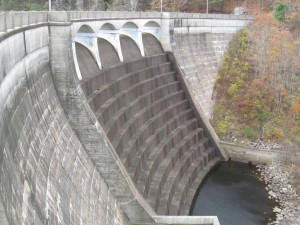Have you ever drunk water in a restaurant in the Hartford region? Maybe you live or work in one of the towns surrounding the City, and get your water from the Metropolitan District Commission (MDC)? We take this seemingly limitless supply of pure, clean water for granted, but in the not-so-distant past, obtaining water in the City was not an easy affair. A recent book by Kevin Murphy called “Water for Hartford: the Story of the Hartford Water Works and the Metropolitan District Commission” details this fascinating story.
Prior to 1855, residents of the bustling City of Hartford obtained their water either from a few shallow wells scattered throughout the City, or by hand directly from the Connecticut River, which was considered a pure source of water at the time. In fact, many people were opposed to spending money to pipe water around the City. Hiram Bissell (ever driven over the Bissell Bridge?) was largely responsible for creating a system that pumped water directly from the Connecticut River, stored it in a small reservoir, and sent it untreated through a small distribution system to large water users and some residential areas. I will spare you all of the details, but suffice it to say this was no small task. In those days, reservoirs construction was done by hand, and with teams of mules, cutting trees, pulling stumps, and moving thousands of tons of soil out of the excavation site.
 By the 1860s, more water was needed due to a growing urban population, and Connecticut River water was becoming too polluted to be consumed safely. Larger reservoirs were constructed in West Hartford, and pristine water from Trout Brook was introduced into the system. Severe droughts in the 1870s and a burgeoning urban population led to the need to add more capacity to the system. Hiram Bissell and Ezra Clark were responsible for performing this seemingly impossible task, along with thousands of men and animals performing backbreaking labor. When even more capacity was needed in the early 1900s, an engineer who had worked on the Panama Canal was hired to oversee the monumental task. Caleb Saville worked tirelessly to survey new lands, oversee eminent domain land purchases, and construct new dams and reservoirs with capacities unimaginable short years before. Saville’s crowning achievement was the construction of the Nepaug Dam, a massive structure that stored enough water to satisfy the needs of ever-growing populations and water needs. In addition to the physical construction of the dam and reservoir, properties needed to be purchased and torn down, highways moved, and cemeteries relocated. Hundreds of families had to uproot their lives so the City could have the water it needed.
By the 1860s, more water was needed due to a growing urban population, and Connecticut River water was becoming too polluted to be consumed safely. Larger reservoirs were constructed in West Hartford, and pristine water from Trout Brook was introduced into the system. Severe droughts in the 1870s and a burgeoning urban population led to the need to add more capacity to the system. Hiram Bissell and Ezra Clark were responsible for performing this seemingly impossible task, along with thousands of men and animals performing backbreaking labor. When even more capacity was needed in the early 1900s, an engineer who had worked on the Panama Canal was hired to oversee the monumental task. Caleb Saville worked tirelessly to survey new lands, oversee eminent domain land purchases, and construct new dams and reservoirs with capacities unimaginable short years before. Saville’s crowning achievement was the construction of the Nepaug Dam, a massive structure that stored enough water to satisfy the needs of ever-growing populations and water needs. In addition to the physical construction of the dam and reservoir, properties needed to be purchased and torn down, highways moved, and cemeteries relocated. Hundreds of families had to uproot their lives so the City could have the water it needed.

In the short space of a blog I can’t afford to provide much detail, but hopefully I have provided enough to at least make you pause the next time you take a drink of MDC water…and give a small thanks to the men and women who worked so hard and sacrificed so much to make it possible.